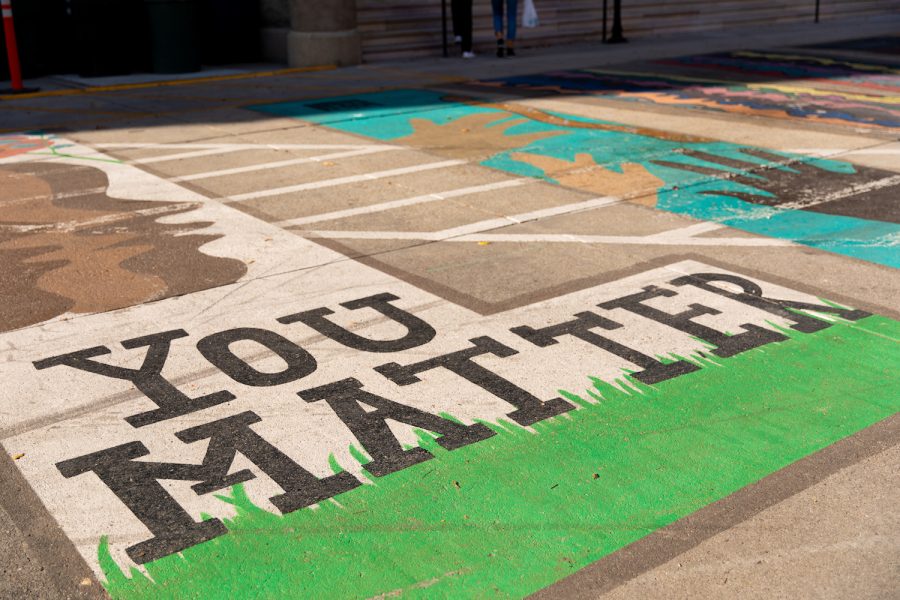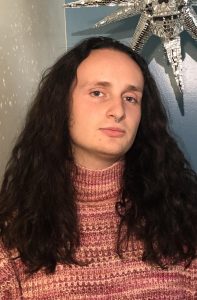What Remains: Returning to the Protest Art Left in Salt Lake
Black Lives Matter mural displayed at the City County buidling in downtown Salt Lake City on Nov. 24, 2021. (Photo by Rachel Rydalch | The Daily Utah Chronicle.
March 3, 2022
I often find myself roaming the streets of downtown Salt Lake City, trying to escape my stuffy apartment, but these are no longer the streets of my childhood, the ones I grew up on. They are forever changed by the Black Lives Matter protests that rocked the city during the summer of 2020. I find myself wondering how these protests and the images they left have seeped into the cold concrete and coarse asphalt. What remains?
The Roads Run Red
Passing by the Salt Lake County’s District Attorney’s office on 500 South, one cannot miss the pools of red that saturate the road. The gallons of paint and handprints that covered the street and much of the building’s entrance are gone now, but even after multiple attempts by the city to paint over it, it still cuts through to the surface — ensuring we never forget.
This faded, yet persistent quality almost adds to the piece’s initial meaning. It still declares that there is blood on the hands of the SLCPD and District Attorney Sim Gill, though the city may try its hardest to paint over the tragedies faced in Utah and absolve the perpetrators of the murder of Bernardo Palacios-Carbajal, and others nationwide.
The aftermath of the piece’s inception is important to understand. Protesters who poured the paint were identified by law enforcement and arrested. Gill then formally drew up felony charges against the group, 8 of which were found guilty, in a move that garnered international attention. Even in its faded splotches of red, this potent piece on many levels decries the racial injustice that plagues our city and state. The pools of paint are unrelenting in their silent screams for justice and accountability.
Faded Acts of Solidarity
In a move by city officials to show support for the Black Lives Matter protests, Mayor Erin Mendenhall commissioned eight artists to paint a mural outside the Salt Lake City City-County Building. The brightly colored mural, according to Mayor Mendenhall’s Deseret News interview, “make[s] it clear that Salt Lake City believes Black Lives Matter and is committed to real change in our community. We’re taking this symbolic step as a city to boldly acknowledge this movement and commit to our role in it.”
But how symbolic was the gesture? The now-fading mural was the target of many white supremacist groups who tried and failed to deface it. These attempts were not deterred by city officials or the SLCPD, but rather armed Black Lives Matter protesters. Former Black Lives Matter director Lex Scott posted TikToks and live-streamed such instances almost daily.
Additionally, Mayor Mendenhall was called to cut the police budget and allocate the funds to other social programs by Black Lives Matter activists and many in the SLC community. While money was moved from the police budget in 2020, funds were reallocated in 2021 for diversity and inclusion trainings as well as social workers, a far cry from the demands for complete reform. According to a KSL interview, officer pay was increased in 2021 in order to attract “quality officers,” a move that feels, again, far from what protestors were fighting for.
The beautiful mural Mendenhall commissioned and the message behind it is powerful and necessary, don’t get me wrong, but it is an undercut made hollow by the inaction behind it. The initial display of solidarity has faded and drifted from the public consciousness, much like the mural itself. The once vibrant colors of the mural have been dissipated by time and broken promises.
Sites of Community Mourning
Out of all the remnants left from the protests last summer, the murals on 300 West and 800 South remain seared into my consciousness. Whether it is the brightly colored faces or the stories they hold, the site with these impactful murals will not easily be forgotten.
The murals not only gave space to and humanize those murdered by the police but also created a site of mourning for them. Unlike the other pieces of protest art left behind, these murals are more than just acts of defiance or solidarity. These murals provide a space for the community to come together to mourn and grieve the loss of life.
The site mourns the loss of 17 people, both local and from around the country, in individual murals. In front of the murals there are often flowers and other tokens of memory left by loved ones and community members. Looking at each mural and seeing these marks of mourning is sobering and grounds police brutality in its reality — one that tears a community apart and leaves them in a constant state of grief.
The public art and protest materials that litter Salt Lake City will fade, but it is this intention of deep, inescapable grief behind each one that will continue to stay with us.








